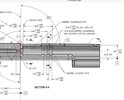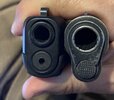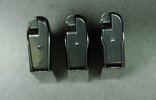The 1911 pistol...like all pistols...is full of angles. Angles everywhere! Some are apparent, some are not. With some of them, the reasons for them are also apparent. With others...not so much.
Examples are:
The grip angle, of course. The feed and barrel ramp angles which to spec are 31-31.5 degrees and 32-32.5 degrees respectively. The reasons are obvious, but some ask why the difference in the two. That's also simple. The barrel ramp aka 'throat" isn't a guide. It's a clearance.
The hammer hook angles, which aren't 90 degrees, by the way. 89 degrees is nominal. That means that when a gunsmith squares and shortens those hooks for a trigger job, he's essentially taking it out of spec, but that's an argument for another day.
Now, as any machinist/toolmaker knows, there is no such thing as a perfect dimension. There must be a +/- tolerance, and the smaller the tolerance, the more critical the nominal dimension.
i.e. The given dimension of a part with a tolerance of +/- .003 inch is less critical than the same part with a tolerance of +/- .0003 inch.
Which brings us to the mysterious angle in the pistol...the breechface angle, which is specified as 89 degrees, 8 minutes relative to the bottom surface of the center slide rail. Mysterious because there is no tolerance provided in the blueprints. None. It violates the first rule of manufacturing. There MUST be a tolerance.
I first noticed that specification in the 60s. At first, I shrugged it off, but when I began my journey into machine tools, it kept coming back. It bugged me. I couldn't shake it. There must be a tolerance...yet, here was a specification on what is arguably one of the most famous of all pistol designs...without one.
Why? Why? Why?
It can't be to match the barrel's tilt. That can vary a bit from one pistol to another for a few reasons. There would be no reason to specify such a precise dimension in order to match up with one that can have so much variation.
When faced with trying to understand a machine's operation, I mentally shrink myself down to .001 inch tall...get inside the machine...and watch the operation in slow motion over and over until I see it...until I'm satisfied that I "get" it. The reason that I do that is simple. If I can understand exactly how and why a machine functions the way it does, I can figure out how to fix it if and when it doesn't function as intended.
So, get your thinkin' caps on and give me your thoughts on this.
Examples are:
The grip angle, of course. The feed and barrel ramp angles which to spec are 31-31.5 degrees and 32-32.5 degrees respectively. The reasons are obvious, but some ask why the difference in the two. That's also simple. The barrel ramp aka 'throat" isn't a guide. It's a clearance.
The hammer hook angles, which aren't 90 degrees, by the way. 89 degrees is nominal. That means that when a gunsmith squares and shortens those hooks for a trigger job, he's essentially taking it out of spec, but that's an argument for another day.
Now, as any machinist/toolmaker knows, there is no such thing as a perfect dimension. There must be a +/- tolerance, and the smaller the tolerance, the more critical the nominal dimension.
i.e. The given dimension of a part with a tolerance of +/- .003 inch is less critical than the same part with a tolerance of +/- .0003 inch.
Which brings us to the mysterious angle in the pistol...the breechface angle, which is specified as 89 degrees, 8 minutes relative to the bottom surface of the center slide rail. Mysterious because there is no tolerance provided in the blueprints. None. It violates the first rule of manufacturing. There MUST be a tolerance.
I first noticed that specification in the 60s. At first, I shrugged it off, but when I began my journey into machine tools, it kept coming back. It bugged me. I couldn't shake it. There must be a tolerance...yet, here was a specification on what is arguably one of the most famous of all pistol designs...without one.
Why? Why? Why?
It can't be to match the barrel's tilt. That can vary a bit from one pistol to another for a few reasons. There would be no reason to specify such a precise dimension in order to match up with one that can have so much variation.
When faced with trying to understand a machine's operation, I mentally shrink myself down to .001 inch tall...get inside the machine...and watch the operation in slow motion over and over until I see it...until I'm satisfied that I "get" it. The reason that I do that is simple. If I can understand exactly how and why a machine functions the way it does, I can figure out how to fix it if and when it doesn't function as intended.
So, get your thinkin' caps on and give me your thoughts on this.
Last edited:




